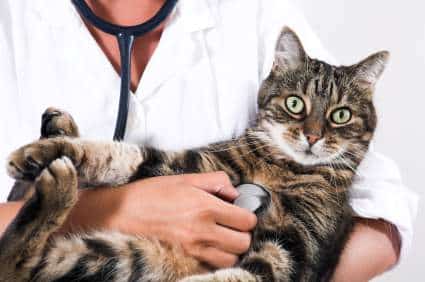
With our busy lives, it can be difficult to strike a balance between work, family, and personal time. In an effort to succeed, we need to place a focus on staying healthy. This includes a good diet, plenty of exercise, and seeing your doctor regularly. Your family veterinarian plays the same role for your pet as your primary care physician does for you.
Just as we should see our doctors annually, your pets need the same to keep them healthy for years to come. One of the most important parts of a preventative health plan is the physical exam.
While we are all taught one year in an animal’s life is equivalent to 7 years in ours, the mathematical equation is more complex and in reality your dogs’ age is often older than you might think. In reality, your pet’s age is often older than you think. If you are one of the few that take your pet to the veterinarian once a year, it’s like you seeing your doctor once every 7 years! Considering most pet owners do not visit their veterinarians office even once a year, that could translate into decades (human years) between health exams for your pet.
Once past the puppy and kitten stage, when animals need frequent medical attention for vaccinations and boosters, an annual exam and vaccination is usually sufficient for health maintenance, unless your pet exhibits unusual behavior. Any signs of appetite change, weight loss, vomiting, diarrhea, coughing, sneezing, or change in thirst could indicate a medical condition requiring attention. Additionally, any lump or bump that persists for more than a few days should be checked by your veterinarian.
Vaccinations, stool checks, and dewormings are a large part the annual visit with your veterinarian. These annual visits are designed to help protect your pet from a variety of diseases that can be contracted from the environment, other pets, and or wildlife. Consult with your veterinarian on which vaccines are best, and how often boosters should be given. Vaccine titers can be performed to determine if your pet has protection against infectious diseases and to determine if a booster is necessary.
As we know, age takes its toll, and as responsible pet owners we need to be aware of our pets needs as they change. Exercise plays an important part a pet’s well being. Dogs and cats were not bred to sit around all day, most have been bred to work pulling carts, hunting, retrieving, etc., so they need exercise. Lack of exercise can cause obesity and joint problems in dogs and cats, as well as contribute to heart disease and other organ dysfunctions. Diet is equally important and should be adjusted based on activity level; supplements provided for stiff achy bones, weight loss programs for our overweight friends and above all, extra TLC.
My motto is a pet is considered a senior at age seven however, different sized animals age at different rates. Giant breed dogs (Great Danes, St. Bernards, Newfoundlands, etc.) are considered to be senior starting at the age of 5 and require twice yearly exams. Medium sized dogs (Golden Retrievers, Laboradors, Australian Shepherds, etc.) can wait until they are 6 years of age, and small breed dogs (Poodles, Pomeranians, Westies, etc) at 7 years of age.
When our pets become senior citizens we need to start checking their insides, as well as, how they feel and look on the outside. We can often see when our pets are having difficulty getting up or limping, but we are not always able to tell right away how their organs are working. Are they developing diabetes? How is their heart functioning? I like to think I can communicate with my pets, but beyond the subliminal messages they send me to give them cookies, they still are not able to tell me when they don’t feel good.
Blood and urine samples can be taken to check for early kidney disease, liver issues, and endocrine disorders such as diabetes and thyroid dysfunction. X-rays of the heart and lungs can tell us if there are any abnormalities, such as an enlarged heart. Ultrasound of the heart and abdomen can help us visualize the internal organs and check for any lumps or abnormal looking areas, as well as function.




